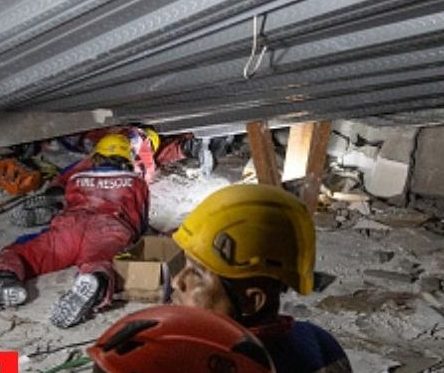
Rescue teams in Sidoarjo, Indonesia, raced against time early Tuesday to reach students trapped beneath the unstable concrete debris of a collapsed school building. More than 12 hours after the disaster, the situation remained critical, with at least one student confirmed dead, dozens injured, and 65 feared buried under the rubble. The collapse took place at Al Khoziny Islamic Boarding School in East Java, a once-respected educational institution that quickly turned into a scene of devastation and sorrow. Throughout the night, rescue workers, police, and military personnel worked tirelessly to pull survivors from the wreckage amid dangerous conditions. By dawn, eight students had been rescued, weak and injured, over eight hours after the building gave way. The discovery of additional bodies raised concerns that the death toll could rise significantly, leaving families in agonizing uncertainty.
Parents and relatives gathered anxiously at nearby hospitals and the collapsed site, hoping for news about their children. Many could only watch in horror as rescuers carried out dust-covered, injured students from the buried prayer hall. A notice board at the command post listed 65 students as missing, a stark reminder of the disaster’s scale. The children—mostly boys in grades seven through 11, aged between 12 and 17—had families waiting with mounting dread for any sign of their safety. “Oh my God… my son is still trapped, please help!” one mother cried out, clinging to hope while others echoed her desperate pleas. Fathers and siblings urged rescuers to find their loved ones alive.
Search and rescue teams faced enormous challenges navigating the unstable structure. Massive slabs of concrete and fractured debris made every movement perilous, requiring extreme caution to avoid further collapse. “We have been delivering oxygen and water to those still trapped beneath the debris to keep them alive while working on extraction,” said Nanang Sigit, the officer leading the rescue efforts. He added that several bodies had been spotted but emphasized the priority was saving survivors. Hundreds of rescuers participated in the operation, equipped with breathing apparatuses, extrication tools, medical supplies, and other vital equipment to manage the crisis. Every second counted as the trapped students fought for survival under the rubble.
Eyewitnesses described scenes of chaos and fear, with local residents, teachers, and school staff aiding injured students. Many survivors suffered head injuries, broken bones, and other serious trauma, requiring immediate medical care. The tragedy occurred while male students were performing afternoon prayers in a building undergoing an unauthorized expansion. Female students, located in another section of the building, reportedly escaped unharmed, highlighting how narrowly some were spared. Officials confirmed that one 13-year-old boy had died, while 99 students were injured and taken to nearby hospitals. Several remained in critical condition, keeping families and authorities on edge.
Investigators swiftly launched a probe into the cause of the collapse. Provincial police spokesperson Jules Abraham Abast explained that the original prayer hall was two stories, but two additional floors were added without the proper permits. “The foundation of the old building could not support two more concrete floors,” Abast said. “The collapse happened during the concrete pouring process, causing this tragic incident.” Rescuers proceeded cautiously to prevent further debris shifts. Heavy machinery was kept away to avoid vibrations that could trigger more collapses, endangering both trapped students and rescue teams.
Relatives of the missing lingered at the site, with some fainting or breaking down in tears as rescue efforts continued. The community’s grief and anxiety were deeply felt, reflecting the emotional toll of the disaster. First responders coordinated medical evacuations on-site, treating injuries ranging from fractures to severe cuts, prioritizing those most critically trapped. The collapse has sparked outrage and concern over school safety standards, especially regarding unauthorized construction. Residents and officials questioned why necessary permits and safety inspections were not enforced.
Despite the devastation, rescuers remained steadfast in their mission. Each moment presented new difficulties, yet their determination to save lives showcased the resilience and dedication of emergency personnel amid disaster. Communities across Indonesia watched the heartbreaking event unfold with sorrow and disbelief. The Al Khoziny Islamic Boarding School collapse serves as a painful reminder of how quickly safety can be compromised and the dire consequences that follow. As rescue and recovery operations continue, families hold on to hope that more students will be found alive. The coming hours will be crucial in determining the full extent of the casualties, while the nation mourns alongside those affected by this tragic event.